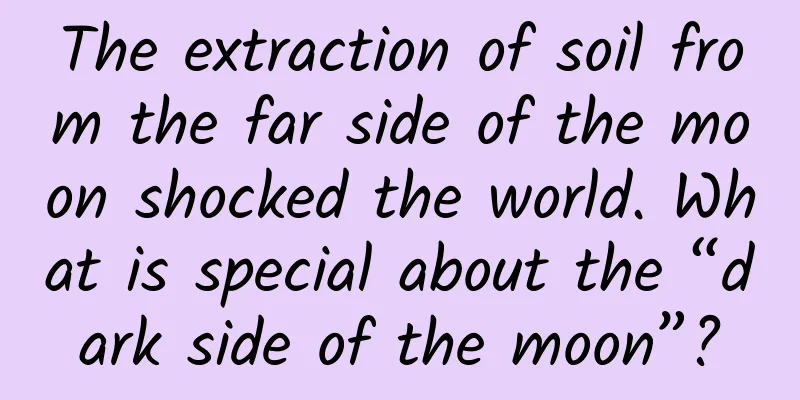The extraction of soil from the far side of the moon shocked the world. What is special about the “dark side of the moon”?

|
Review expert: Qian Hang, aerospace science expert of the First Academy of China Aerospace Science and Technology Corporation Did you know that the moon always has a "dark side" that humans on Earth cannot see? In many science fiction novels and movies, there are many aliens and alien bases on the dark side of the moon. In fact, the moon does have only one side facing the earth, and its back cannot be seen from the earth. However, it is not appropriate to call the back of the moon the "dark side" because it is only facing away from the earth, but it can also be illuminated by the sun, so it is not dark. Why can't we see the far side of the moon ? The moon used to rotate at a relatively fast speed, but the gravity from the Earth constantly exerted a force on the moon. This force was opposite to the direction of the moon's rotation, like pulling the moon back, causing the moon's rotation speed to slow down continuously until the period of rotation around its axis was the same as its revolution period around the Earth, which is 27.32 days. The picture shows the phases of the moon Therefore, the moon now always faces the earth with the same side, which is what we often call "tidal locking". The moon has two faces We usually call the side of the moon facing the earth the front side, and the other side opposite the moon the back side, which people usually call the "dark side". However, the dark side does not mean that the back side of the moon will always be in darkness. In fact, it will be illuminated by the sun just like the front side. Some scholars have found that when the moon is in the new moon phase, the front side of the moon is dark, while the back side of the moon is illuminated by the sun. More and more probes going to the moon have made people discover that the back and front of the moon are very different, as if the moon has two "faces": the front is relatively flat, while the back is rugged and covered with impact craters. The picture shows the back of the moon Whether in terms of material composition, morphology or rock age, the front and back sides of the moon are very different. For example, in terms of composition, about 60% of the front side of the moon is covered by lunar mare basalt, while the back side is almost all highland anorthite. There are 22 lunar seas on the moon, 19 of which are on the front side, and only 3 very small lunar seas on the back side. In addition, the lunar crust on the back side is thicker than that on the front side, with the thickest part reaching 150 kilometers, while the thickness of the lunar crust on the front side is only about 60 kilometers. What are the lunar seas? Actually, they are not the "seas" we are familiar with. Early observers found that some areas on the lunar surface were darker, so they guessed that these areas were oceans because their reflectivity was lower than other places. In fact, this is because the surface is covered with basalt material. The largest lunar sea on the moon is the Ocean of Storms, which covers an area of 5 million square kilometers, which is about the size of 9 France. The Continuing Exploration of the Dark Side of the Moon In 2004, China officially launched the lunar exploration project and named it the "Chang'e Project." On December 8, 2018, after more than 20 days of orbiting the moon, the Chang'e-4 probe finally landed on the far side of the moon on January 3, 2019. This was the first soft landing of a human probe on the far side of the moon. After billions of years of waiting, the mountainous wasteland on the side of the moon that always faces away from the earth finally welcomed the first visitor from the earth. On June 2, 2024, Chang'e-6 landed at the pre-selected landing site in the South Pole-Aitken Basin on the far side of the moon, successfully completed the lunar soil sampling mission, and returned to Earth smoothly on June 25, 2024, bringing back approximately 2 kg of lunar far side samples, marking the world's first lunar far side sampling return. Sharing a full moon and looking at the stars together. The moon always gives us room for imagination and makes us want to explore it more. The continuous exploration of the "dark side of the moon" is imprinted with the steps of countless scholars and predecessors who have never stopped pursuing. May we continue to explore the mysteries of the stars and challenge all the unknown worlds! References: National Geographic China: The Moon, Humankind's Continuous Exploration National Geographic China: "The Scarred Guardian of the Earth: A Close Look at the Tens of Thousands of Impact Craters on the Moon" Popular Science China: "Humanity's first sample collection from the far side of the moon. The lunar soil is obviously not suitable for growing vegetables. Why did Chang'e go to the moon to dig soil?" |
<<: The calla lily with a comet-like long tail turns out to be poisonous!
Recommend
Cook rarely speaks out: Virtual reality is quite interesting and will become mainstream in the future
According to the technology website TechRadar, to...
3 key points to capture "effective" traffic! ! A must-read for copywriters!
Most employers have a misunderstanding about new ...
Beijing CDC issues health tips for New Year's Day and Spring Festival: encourage people to avoid peak travel times, return home, return to work, and return to school during the Spring Festival travel rush
At present, the epidemic is spreading abroad, and...
CCB App launches digital currency: can be used for salary payment and shopping, similar to WeChat change
[[339956]] According to domestic media reports, t...
Red umbrellas and white stems, how did the ancients eat mushrooms?
If you are a web surfing enthusiast, you must hav...
Can you watch YouTube on Android Wear?!
Smartwatches have dominated the tech headlines in...
Are humans the only animals that cannot swallow and breathe at the same time? This 60-year-old theory may be a fallacy
The assertion that "humans lost the ability ...
How much does it cost to join a book mini program in Tai'an?
How much does it cost to join a book mini program...
Don’t say “pink and tender”, it is the real version of “beautiful scenery in the desert”
There are countless magical and beautiful plants ...
180,000 trees! Why do we need to plant Haloxylon ammodendron to prevent wind and fix sand?
Review expert: Dong Wenpan, associate professor o...
New iPhone will upgrade fingerprint module: less mistakes and more secure
On the morning of February 11, 2015, KGI Securiti...
WeChat upgraded with new features: My three-year-old phone is no longer stuck!
Regardless of the model, high configuration or lo...
Juyi Thinking's most profitable project on Douyin in 2021, Oral Broadcast Number 1.0
【Juyi Thinking】The most profitable project of Dou...
Even bullets can’t break it, why is Rupert’s Tear so magical?
There is a very interesting little thing called &...
My 20 operating notes may be helpful to you
It’s the end of August, the tail end of summer, a...



![[2014 WOT Shenzhen Station Lecturer Interview] Tencent Zhang Dan: Mobile games will be further segmented](/upload/images/67ebf21cb46f2.webp)





